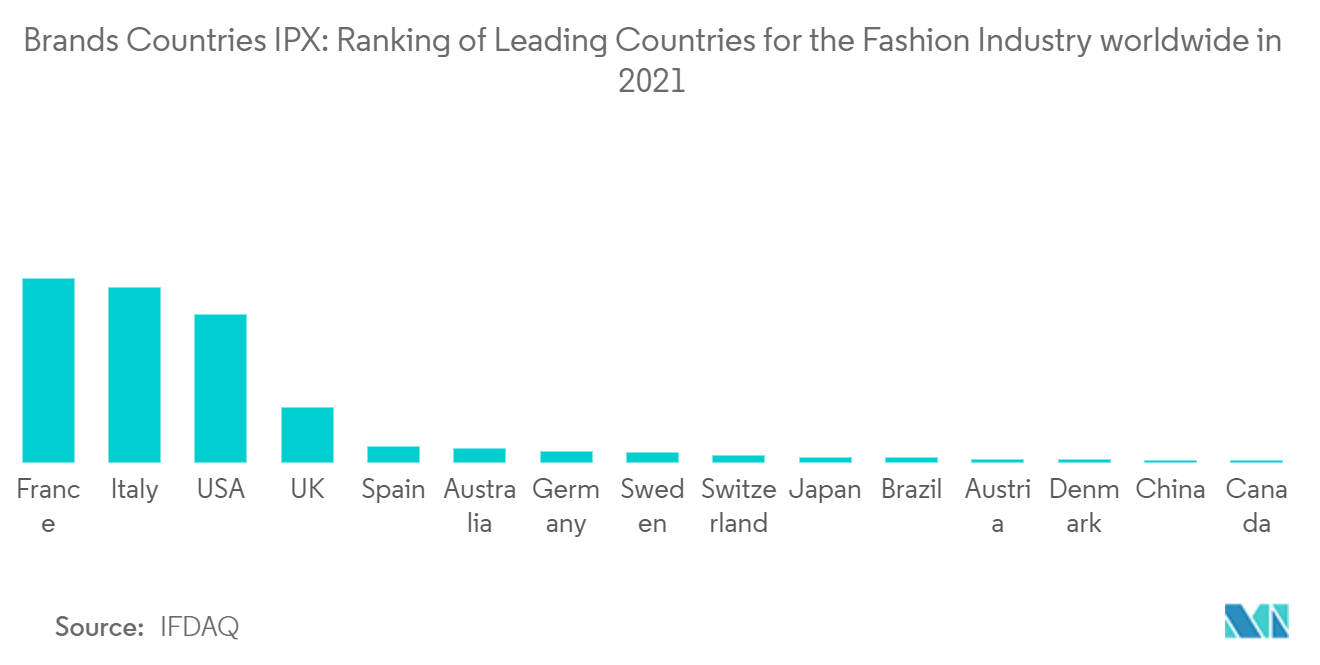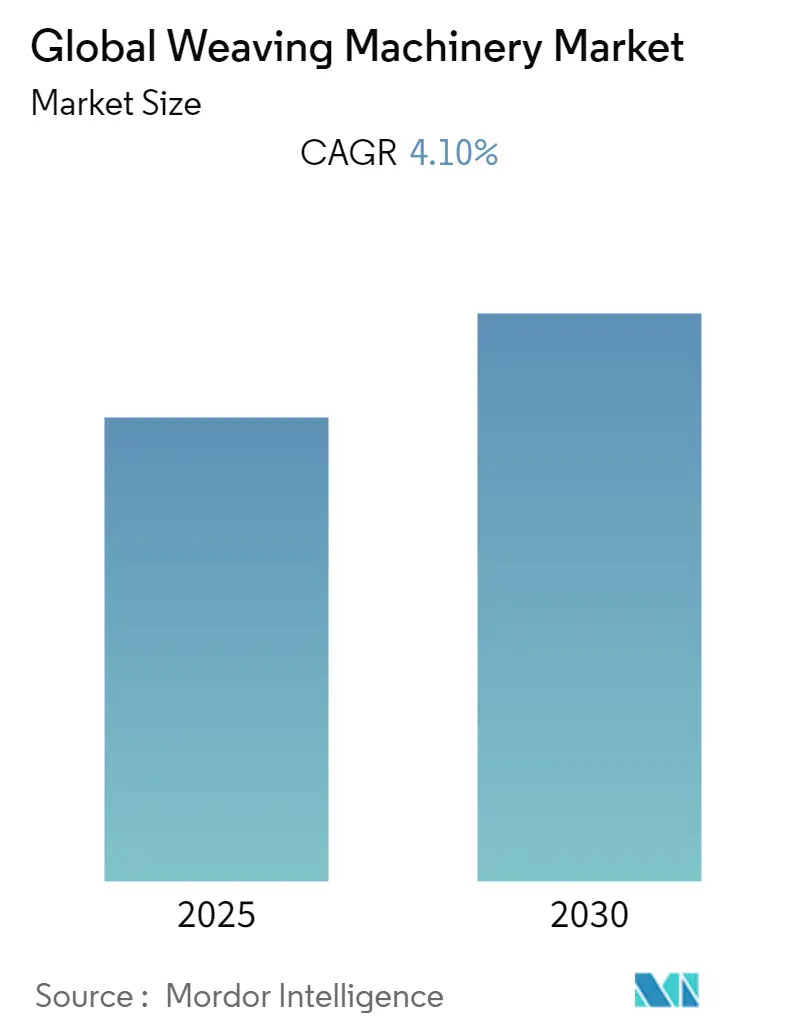
| Study Period | 2020 - 2030 |
| Base Year For Estimation | 2024 |
| Forecast Data Period | 2025 - 2030 |
| CAGR | 4.10 % |
| Fastest Growing Market | Asia |
| Largest Market | Asia |
| Market Concentration | Low |
Major Players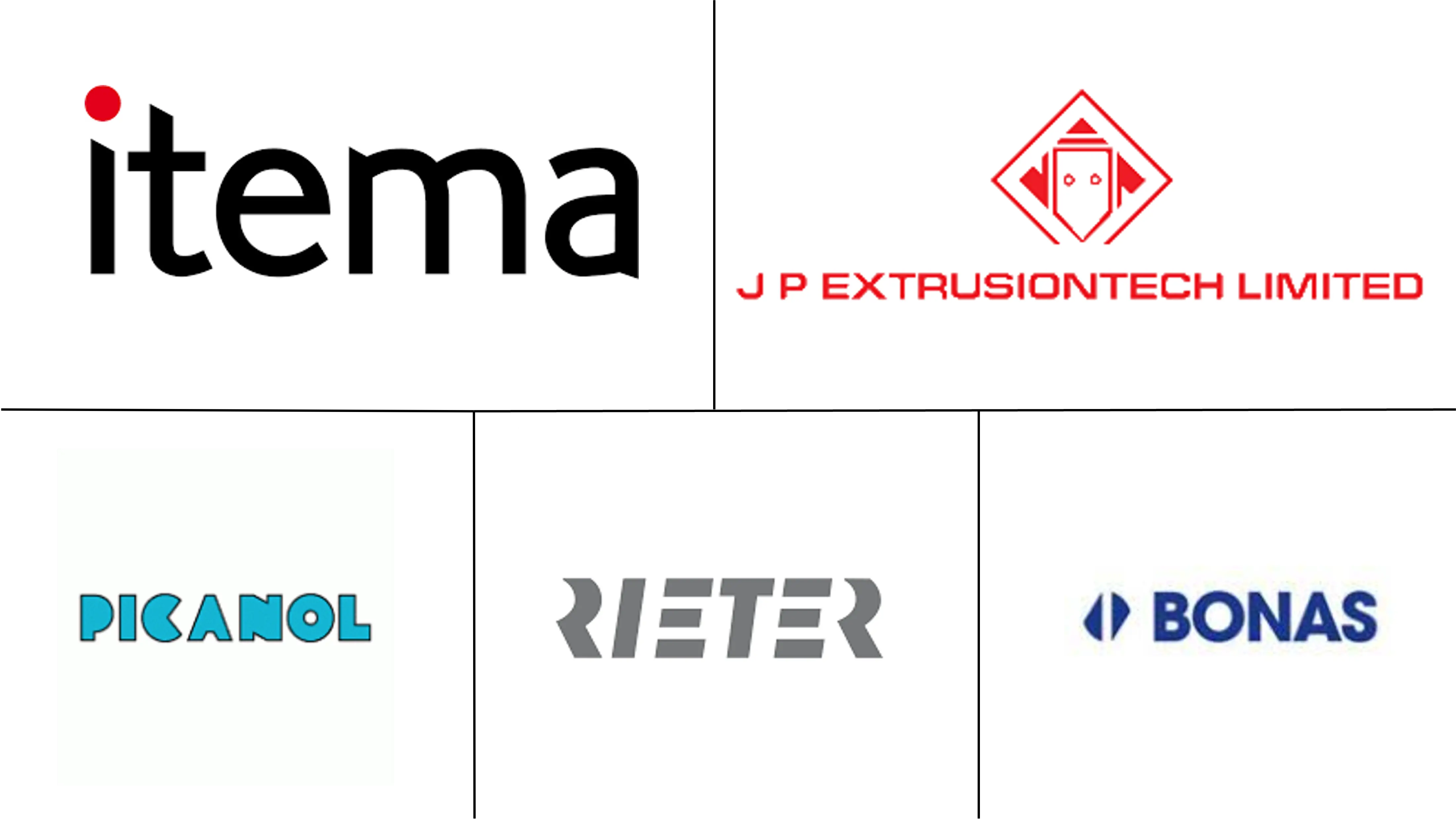
*Disclaimer: Major Players sorted in no particular order |
Weaving Machinery Market Analysis
The Global Weaving Machinery Market is expected to register a CAGR of 4.1% during the forecast period.
The outbreak of COVID-19 has compelled government authorities to take stringent measures. Partial or complete lockdowns were imposed in several emerging and developed countries to minimize the spread of the virus. The manufacturing was restricted to permissible limits under the lockdown.
With the rising global population and resultant intake of apparel based items, the weaving machine market growth is expected to further ascend along subsequent periods. Additionally, the advent of technical fabrics requiring the need of woven items will incur the usage of weaving machines. The packaging industry for industrial bags and sacs is expected to offer growth opportunities in future for weaving machines owing to the variety of woven articles produced. On the hindsight, the emergence of non-woven items may act as a deterrent to the growth of weaving machines market.
Weaving machine have widespread applications in clothing and textile manufacturing industries, for the fabrication and processing of textiles, fabrics, and other woven materials. In some special cases weaving machine are also used for weaving of metal wires in industrial applications.
On the back of rise in textile and clothing manufacturing across the globe weaving machine market is expected to witness substantial growth during the forecast period. The manufacturers are also focusing on manufacturing of products with higher efficiency and durability.
Weaving Machinery Market Trends
Technology in the Industry
Deployment of smart automation in the weaving machine are projected to create positive prospects for the growth in demand for weaving machine market. Automation is used in weaving industry specially in winding, warping, sizing also used in loom. Some processes have been completely automated. The biggest benefit of automation in weaving machineries is that is saves labor, however, it is also used to save energy and materials and also to improve quality & accuracy.
Companies operating in the fashion sectors are also highly interested in the application of blockchain technologies. The most interesting application fields in this sector were supply chain traceability and anti-counterfeiting, followed by supply chain management and cyber security.
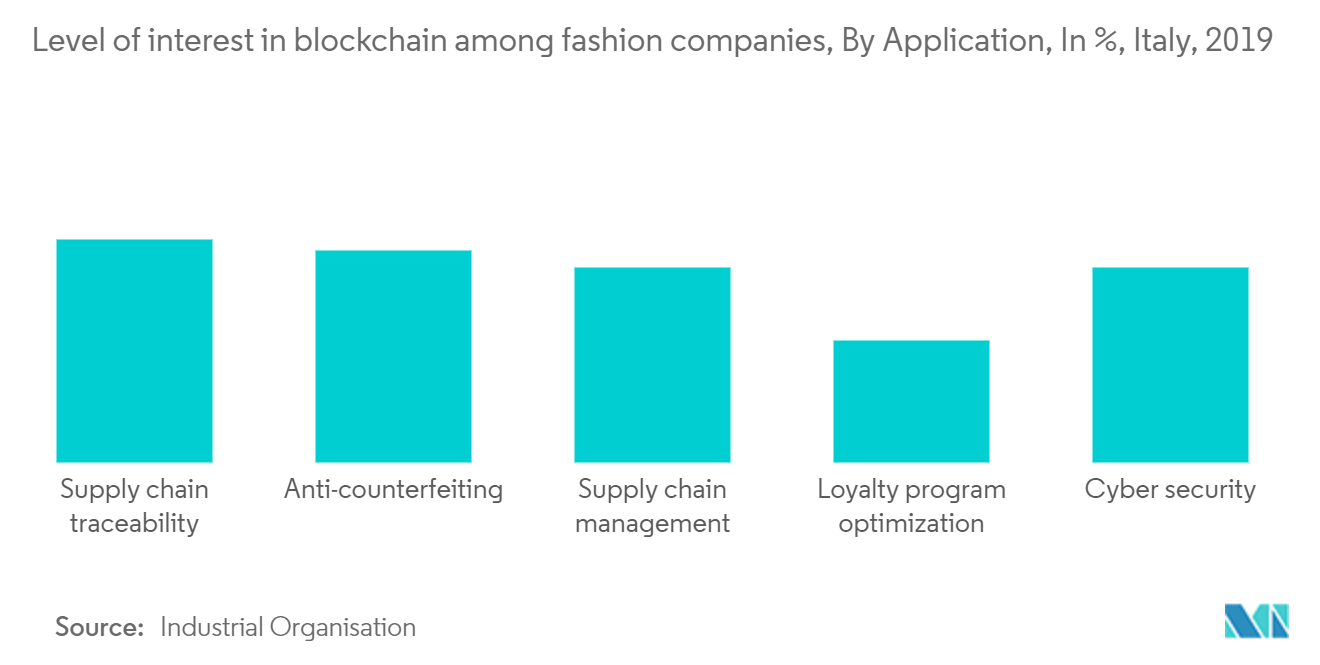
Growing Fashion Industry Across the Globe
The global fast fashion market size is expected to grow from USD 91.23 billion in 2021 to USD 99.23 billion in 2022 at a compound annual growth rate (CAGR) of 8.8%.
Increasing adoption of affordable clothes by the rising youth population drove the fast fashion market. According to the United Nations estimates of the world's youth population, in 2019 the youth population totaled 1.2 billion and it's projected to grow by 7.9 percent to 1.3 million by 2030. Youth population is attracted to unique, trendy and affordable clothes. The apparel manufacturing companies are therefore focusing on bringing fashion clothes from the most recent fashion trends presented in fashion week. The growing preference for affordable fast fashion clothes by increasing youth population boosted the fast fashion market.
Virtual and augmented reality is being used by online and offline retailers in the fast fashion market. The use of virtual or augmented reality in the fast fashion market is to fill the gap between online and offline channels. These technologies enable the customer to try the product and see how it looks when they try the clothes or make-up on them by using virtual reality mirrors or cameras in their smartphones.
Weaving Machinery Industry Overview
The report covers the major players operating in the weaving machinery industry. In terms of market share, the companies in the global weaving machinery industry do not have a considerable amount of market share, as the market is highly competitive and fragmented.
Some of the leading companies around the world are Picanol, Reiter, ITEMA, BONAS, J P Extrusiontech among others.
Weaving Machinery Market Leaders
-
Picanol
-
Reiter
-
ITEMA
-
BONAS
-
J P Extrusiontech
- *Disclaimer: Major Players sorted in no particular order
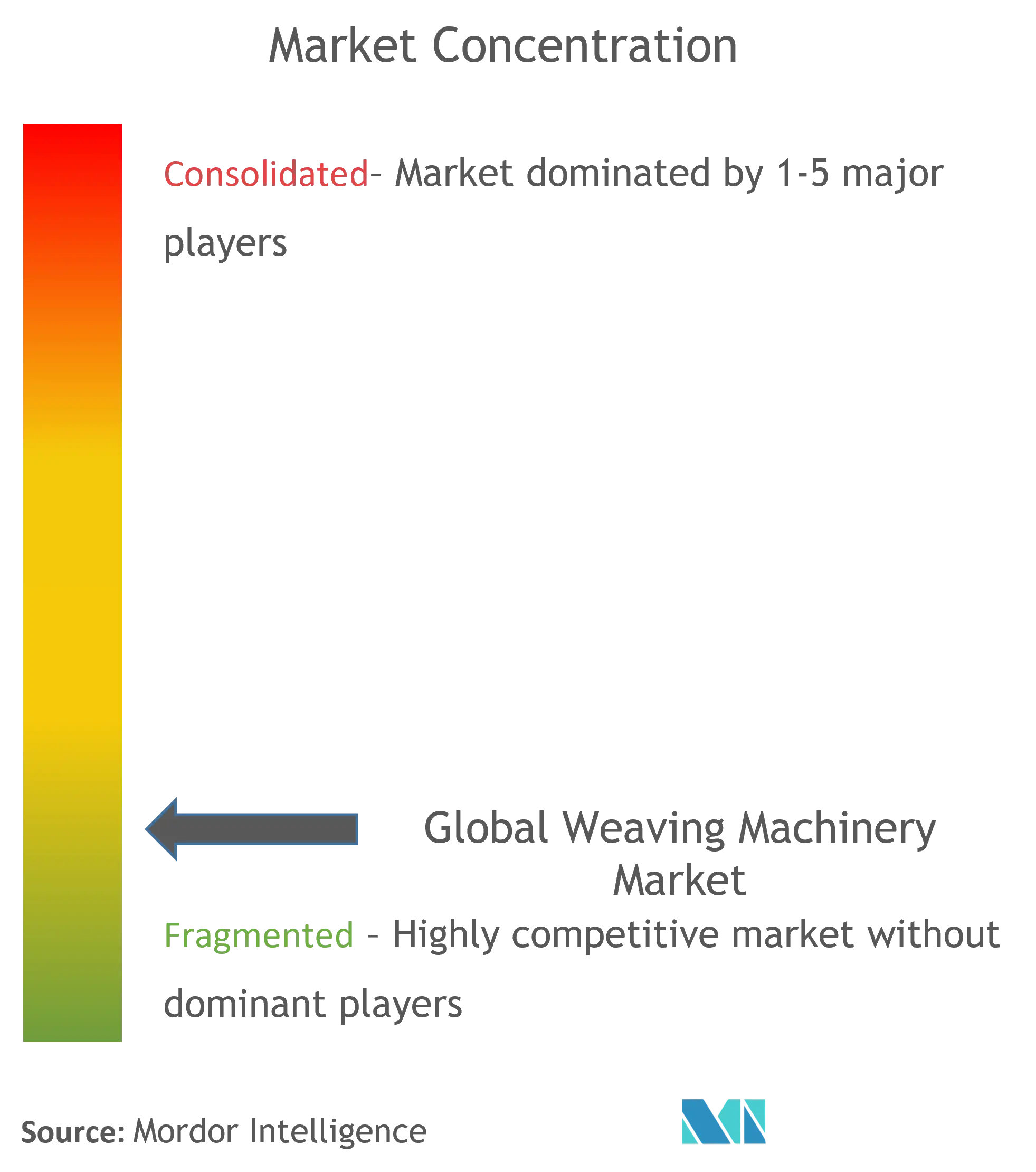
Weaving Machinery Market News
- May 2022: Itema, the leading provider of advanced weaving solutions including weaving machines, spare parts and integrated services, announces the establishment of a new company in Turkey. The Turkish subsidiary, that operates under the name İtema Tekstil Makineleri Servis Sanayi ve Ticaret Limited Sirketi, began its operations in Istanbul - company headquarters - and Bursa - company branch office.
- May 2022: PicConnect, a fully digital platform, is now available for all Picanol customers. PicConnect offers a wide range of features, from industrial IoT to service-related applications. Connecting Picanol weaving machines to PicConnect will allow one to leverage the full extent of the machine possibilities.
Weaving Machinery Industry Segmentation
Weaving machine is a device mainly used for weaving fabrics and tapestry. The basic function of a weaving machine is for holding the warp threads under tension for enabling the interweaving of weft threads. Weaving machine can be used for various types of weaves such as plain Weave, satin weave, twill weave, etc. The Global Spinning Machinery market is segmented by Machine Type (Shuttle Weaving Machine, Circular Weaving Machine, Others), by Weaving Type (Plain Weave, Satin Weaving, Twill Weaving, Others), by Application (Clothing, Upholstery Fabric, Automotive Textiles, Sportswear, Others) and by Geography (North America (United States, Mexico and Canada), Asia-Pacific (China, Japan, India, Bangladesh, Turkey, South Korea, Australia, Indonesia and Rest of Asia), Europe (Germany, France, United Kingdom, Italy, Spain, Russia and Rest of Europe), Middle East & Africa (Egypt, South Africa, Saudi Arabia and Rest of Middle East & Africa) and South America (Brazil, Argentina, Rest of South America)). The report offers market size and forecasts for Global Spinning Machinery market in value (USD billion) for all above segments.
| By Machine Type | Shuttle Weaving Machine | ||
| Circular Weaving Machine | |||
| Others | |||
| By Material | Plain Weave | ||
| Satin Weave | |||
| Twill Weave | |||
| Others | |||
| By Application | Clothing | ||
| Upholstery Fabric | |||
| Automotive textiles | |||
| Sportswear | |||
| Others | |||
| By Geography | North America | United States | |
| Canada | |||
| Mexico | |||
| Europe | United Kingdom | ||
| France | |||
| Italy | |||
| Spain | |||
| Germany | |||
| Russia | |||
| Rest of Europe | |||
| Asia-Pacific | India | ||
| China | |||
| Japan | |||
| South Korea | |||
| Southeast Asia | |||
| Australia | |||
| Rest of Asia-Pacific | |||
| Middle East & Africa | Saudi Arabia | ||
| United Arab Emirates | |||
| Qatar | |||
| South Africa | |||
| Rest of Middle East & Africa | |||
| South America | Argentina | ||
| Brazil | |||
| Chile | |||
| Rest of South America | |||
Weaving Machinery Market Research FAQs
What is the current Global Weaving Machinery Market size?
The Global Weaving Machinery Market is projected to register a CAGR of 4.1% during the forecast period (2025-2030)
Who are the key players in Global Weaving Machinery Market?
Picanol, Reiter, ITEMA, BONAS and J P Extrusiontech are the major companies operating in the Global Weaving Machinery Market.
Which is the fastest growing region in Global Weaving Machinery Market?
Asia is estimated to grow at the highest CAGR over the forecast period (2025-2030).
Which region has the biggest share in Global Weaving Machinery Market?
In 2025, the Asia accounts for the largest market share in Global Weaving Machinery Market.
What years does this Global Weaving Machinery Market cover?
The report covers the Global Weaving Machinery Market historical market size for years: 2020, 2021, 2022, 2023 and 2024. The report also forecasts the Global Weaving Machinery Market size for years: 2025, 2026, 2027, 2028, 2029 and 2030.
Our Best Selling Reports
Global Weaving Machinery Industry Report
Statistics for the 2025 Global Weaving Machinery market share, size and revenue growth rate, created by Mordor Intelligence™ Industry Reports. Global Weaving Machinery analysis includes a market forecast outlook for 2025 to 2030 and historical overview. Get a sample of this industry analysis as a free report PDF download.



